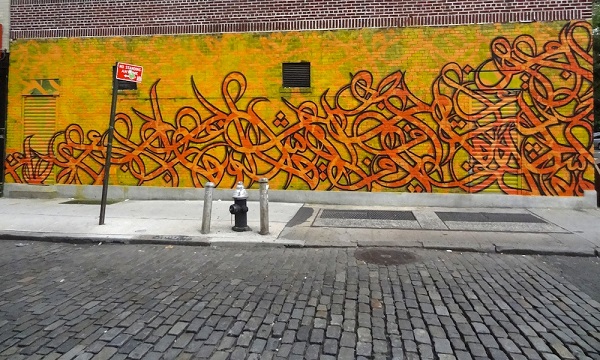Art World
Tunisian Street Artist eL Seed on His Month-Long Mural-Making Road Trip
The "calligraffiti" artist spent a month crisscrossing his country painting walls.

The "calligraffiti" artist spent a month crisscrossing his country painting walls.

Canvas Daily


Last summer, the Tunisian-born calligrafitti artist eL Seed spent a month touring his country, visiting 17 cities and towns and painting 24 walls across Tunisia in the process. The journey culminated in Lost Walls, a 160-page book that launched at Art Dubai, which documents this artistic road trip and includes a preface by Jeffrey Deitch. The artist has just come back from Jeddah, where he painted a wall in the city’s old town, Al-Balad, and is in Dubai as part of a residency program with Tashkeel. Canvas Daily discusses the trip, the book and everything in between with eL Seed.
What was the journey like?
I crossed Tunisia from north to south, east to west, going to places that people don’t know or somewhere with a lot of history but which has been forgotten. Most of the time, I did not know anyone; I’d just stop, meet people, hear their stories, paint a wall and leave.
Was there something you were searching for?
Just the pleasure of painting and to meet and share with people. I know my city Gabès and some cities in the North but there were many places that I had never been to, like those on the coast. There were so many stories—the kind you read on the Internet or in books and I got there and realized that some of them are untrue or more than one expected. It helped me know more about my people, my country, and myself.
How long did it take to paint each wall?
There are some that took about 40 minutes and others that took me four days because during a trip like that, you get really tired. My team [photographers and videographers] and I started from the south, then crossed the desert and went back to the sea where we spent about four days. I painted a wall right next to the beach—it was big, so I took my time.
Was a month enough?
Time was really tight, but I was focused. We selected some cities and there are some places that we could not visit because of time. If I had three months, it would have been totally different, but one month was cool even though it was short.
Did you know what to paint on each wall?
Most of the time, you go there, you meet people, they tell you stories, and you create something based on that.
What was it like meeting all those people?
Some invited us into their houses and lives and told us personal things. I met a fisherman who lived on Kerkennah Islands, who told me about his way of fishing and simply talking about it gave him hope. I met an artist who told me that he saw himself in me and how sometimes, you need someone from the outside to tell you how beautiful you are. It is funny to see how people get involved in your work when you want to paint a wall or look for one. One man was hoping that this project would bring people back to Tunisia.
Did you stop to consider the wall before painting it?
Yes and I also thought about its picture for people to see the things that surround it and its environment. Sometimes I felt like the wall had been built for me—I once found one in the middle of nowhere and I painted the word “alone” on it.
Would you like to paint a wall in Dubai and other parts of the Arab world?
Yes, why not! I am actually eager to develop my studio work as well, maybe change my mentality towards street art. Every time I want to go to Beirut, something happens. I am supposed to go to Cairo this year and I’d like to go to Jordan and Kenya as well.
This story originally appeared in Canvas Daily, an artnet News content partner.